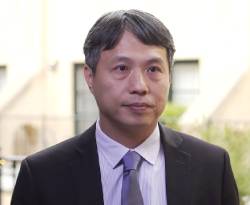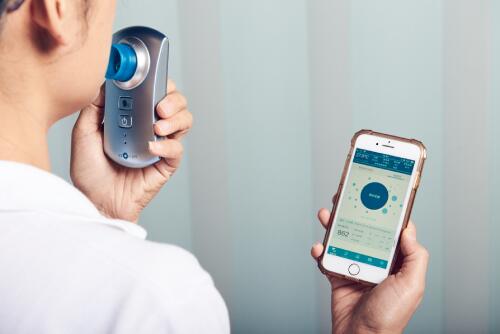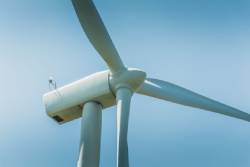Finding Inspiration in a Dog Whistle
Article By : Matthew Burgess

A startup in Taiwan, inspired by the Galton whistle, has developed a spirometer which they believe will become as synonymous with daily life as a heart-beat monitor.
In a press conference last month, Tsai Li-chuan, deputy chief executive of Formosa Cancer Foundation announced that Taiwan has the 15th highest incidence of lung cancer in the world, second in Asia only to North Korea. Early signs of lung cancer can be very difficult to catch, and more than half of all cases are diagnosed in the advanced stages of the disease.
People often associate lung cancer with smokers but nearly half of Taiwanese patients diagnosed with lung cancer have never smoked. It is believed by experts that two of the major contributors to lung cancer in Taiwan is air pollution and fumes from cooking oil.
In an interview with EE Times Asia, the CEO and Co-Founder of Genius Holdings, Duncan Chen, explains that he was motivated to develop a spirometer (an apparatus for measuring the volume of air inspired and expired by the lungs) following his son’s asthma diagnosis at only 3 years old. “My son is now 7 years old and if he has an Asthma attack, we need to carefully monitor his condition for several days”. Chen explains that this process would normally require multiple visits to a clinic for tests, which can often be tiresome and expensive.

Duncan Chen, CEO Genius Holdings
“We started this project due to the air pollution problem and we tried to do something to improve the quality of people’s lives. Developing a medical grade device requires a lot time and capital. Instead, we decided to develop [ezOxygen](https://www.ezoxygentech.com/) as a health awareness product. This has allowed us to go to market much quicker and start to help people”.
Genius Holdings’ wireless spirometer, ezOxygen, sets itself apart in the market as it uses passive ultrasonic detection to determine the airflow rate, as opposed to traditional turbine technology. A standard spirometer relies on moving parts to record results which can keep moving once the test has finished. Chen believes that this creates an inertia problem and lowers the accuracy of results.
Chen explains that he was inspired by the Galton whistle, more commonly referred to as a dog training whistle. Modifying this technology, the airflow generates a resonant frequency response through the metal whistle, this signal is then converted into flow rate and flow volume using Genius Holdings’ algorithm. “We are recording the ultrasound signal intensity and then using our algorithm to recover the airflow rate. This is a new technology which we have developed, and we have patents in Taiwan, Japan, South Korea and China, we’ll hopefully add the U.S, and UK next year” said Chen.

Chen believes that ezOxygen can operate as a ‘lifestyle’ device and hopes that it will one day be used in a similar fashion to heart-beat monitors. The team Genius Holdings have designed an app which records the data from each usage and plots your results on a graph. Accompanied with real-time weather and air quality updates, Chen feels that the power of ezOxygen is that it allows users to make informed decisions about their own health. Chen highlights that, “each person has a different condition. For me, an inhaler’s working time could be 4 hours but for you it could be 6 hours, but how could a doctor know that?”.
For now, ezOxygen remains a ‘health awareness’ device but Genius Holdings have plans to apply for CE marking and FDA approval next year.
From Medical to Industrial applications
Achieving a sample rate of 10,000 samples per second, Chen has ambitions of taking his technology beyond healthcare and developing industrial applications.
“When we finished the product, we thought if we can be so accurate with a human, why don’t we look at industrial applications such as wind power generation or industrial tunnel airflow rate determination?” says Chen. “A mechanical sensor has a durability problem, when you put a sensor spinning inside a tunnel for a year or two it will break but if you use a whistle instead, it’s very interesting”.
Chen’s plan is to spinout a new startup next year and launch an industrial product called ‘WindNet’. He is very excited about its potential application in industrial airflow rate determination for wind power generation.

WindNet would sit on top of an ocean-based wind turbine nacelle and act as an anemometer, determining both the wind power and direction. Wind turbines use anemometers to establish the turbine’s best position, using this information, a wind turbine can then change direction or even pitch to ensure that the optimum amount of power is extracted from the wind.
Current mechanical solutions have durability problems according to Chen, they require regular maintenance which can become costly. “Many anemometers use turbine technology, wind cups or some may even use ultrasonic sensors. The ultrasonic technology currently in use may not last more than a couple of years before their intensity decreases but as we use passive ultrasonic technology, we do not have this problem”.
This isn’t Chen’s first startup and he isn’t daunted by the proposition of entering another industry as he explains that they were better known for drug development before they started work on a spirometer. “My focus was biotech. I started a drug development company in 2011 with $80,000 USD and after only 3 years of development we received a valuation of $75M USD” says Chen. “When we started development on ezOxygen in 2016 we only had one idea, maybe a dog training whistle can be used to determine airflow rate in people”.
It’s clearly important to Chen that he does what he can to make the world a better place and views himself purely as a researcher. He created his first company, Original BioMedicals to develop radiation medication following the fukushima nuclear disaster in 2011. Following his son’s asthma diagnosis, he then developed a spirometer to improve the quality of life for those which suffer from respiratory conditions. His new direction is to improve the efficiency of power generation, which Chen feels is a continuation of his desire to improve the world around him. “If we have to work all day, why not do something to make the world better? I know that some entrepreneurs can have tough times but when I come to the office I’m singing”.
Subscribe to Newsletter
Test Qr code text s ss


